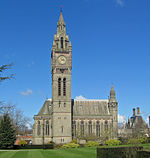Eccleston Ferry House
Grade II listed buildings in CheshireGrade II listed housesGrosvenor familyHouses completed in 1887Houses in Cheshire ... and 2 more
John Douglas buildingsTimber framed buildings in Cheshire

Eccleston Ferry House is a farmhouse southeast of the village of Eccleston, Cheshire, England. It is on the east bank of the River Dee near the site of an ancient ferry crossing of the river. The house is recorded in the National Heritage List for England as a designated Grade II listed building.
Excerpt from the Wikipedia article Eccleston Ferry House (License: CC BY-SA 3.0, Authors, Images).Eccleston Ferry House
Paddock Road,
Geographical coordinates (GPS) Address Nearby Places Show on map
Geographical coordinates (GPS)
| Latitude | Longitude |
|---|---|
| N 53.1533 ° | E -2.8745 ° |
Address
Paddock Road
CH4 9HP , Eaton and Eccleston
England, United Kingdom
Open on Google Maps








